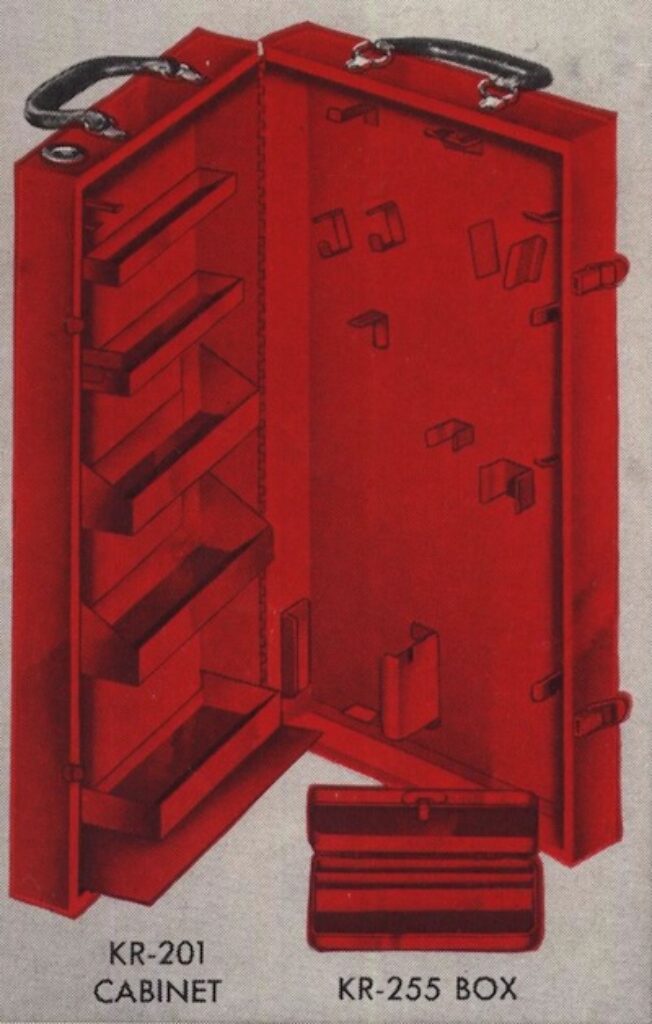Super Service Sets 1923-1950
Super Service Sets 1923-1950
The Superset is the forerunner of the modern tool chest. Then as today, having a great set of tools was a mark of an excellent mechanic. The ultimate set offered during this period was appropriately named the “Super Service Set”. The Super Service Set collected the comprehensive collections of the ½ inch and 5/8-inch socket sets into a single cabinet.
Supersets fall into two periods.
The first period lasted from 1923 until 1932. This early period was the height of the Super Service Set popularity and features 4 main variations.
The second period started around 1932 and continued into 1950. In 1932 the classic Super Service Set Cabinet finally could not keep up with the size required for a complete set. The mechanics of the day migrated into rollaway, tool chests and other larger toolboxes. The Super Service Set remained in the catalog through WWII, but the buyer tended to be more industrial (railroad, factory and mill users). The signature Super Service Cabinet really became a big case for large socket sets (3/4 inch drive) and the model number of the set changed to the 475, the 477 and finally the 5073/74 sets
First B-12 Super Service Sets 1923-24
These are the forerunners of the modern tool chests. These are the ultimate sets offered during their time. The 1923 Catalog A shows a cabinet featuring “the complete socket wrench equipment for automobile mechanics and also for Plant Engineers of industrial, hotel, office and public buildings.” Identifying these sets is straightforward. The tools are described in detail within the catalogs, but the cabinets are not. The cabinets fall into 4 basic versions. The following differences identify the version of each cabinet:
– Paint finish – the earlier sets are green enamel and the later are Black Lacquer
– Tool Mounts and Locations. The location and type of hangers, clips and tabs change in each version.
– Labeling and Brass Tags. These changed from Labeling to riveted Brass tags and back again
– Hinge, Handle and Hasp layout. The earliest set uses different hinges and hasps, the post 1932 sets use different handles
The first cabinet appeared in 1923 and this version is unique in the following ways:
Paint finish – This set uses a green enamel finish. It is used only on the first two sets. Green means “early” and must be one of the first two versions.
Tool Mounts and Locations – On the left side there are 2 pockets. This is the only version using two pockets, in these locations. This is a pre-ratchet set so no place exists for a ratchet. The handles lay in shelves sized for each. The right side has 6 places to hang handles and extensions vs. 7 for all the other boxes. There are 5, independent socket shelves.
Labeling – Snap-on labeled these sets with decals. None have brass tags. Brass tags do not appear until 1926 and are used through 1932.
The Super Service Sets label location changed over the production run. The outside of the cabinet has no known label. On the inside, labels appeared on the right or the left side of the cabinets.
There are two known examples for label location: right and left sides.
The black lacquered cabinets in later versions always have the label on the left side. We speculate the right side labeled 1923 set is early in the production. The label located on the left are later 1923 and 1924 production cabinets.
The label is gold, showing the correct layout for these tools in this cabinet along with identifing the makes. See the photo above and to the right.
Hinge, Handle and Hasp layout – This first version is easy to identify by looking at the hinges. It uses two (2) individual hinges top and bottom. It is the only version to use these – all others use a full length piano hinge. These hinges screw into the cabinet, all others are spot welded in.
The type of hasp is also unique to this version. The hasp is spring steel. This flexes the female side. The hasp is riveted in. All other sets spot weld in a hinged hasp. Both the riveted and spot welded hasps exist in this first version. It must be the earlier cabinets had the riveted hasp, and later in the production run it was switched to the spot welded / hinged hasp.
The handles are “spring” handles – this is a signature mark of the first series and remains until 1932 with the start of the 475 and 477 sets.
All of the sockets in the 1923 and 1924 sets are “Strike Over” (S over O) and all the handles (No 3, The S-5, No 5 Brace and HD-5) have pinched shafts. These are vertically stacked.
Vertically stacked socket shelves are used in 1923 1924 and disappear until 1932.
Here is another great example from Ken and Roseanna Johnson
Paint finish – the original green enamel is in great shape
Tool Mounts and Locations – The pockets are exactly the way they should be
Labeling – On the inside the label is on the left side. The cabinet above has the same label on the right side. This label is the same gold color with the tool layout for this cabinet.
Hinge, Handle and Hasp layout – This has the 2 individual hinges top and bottom. It also has the spring steel hasp


Version 2 - the 1925, B-2 Super Service Set
The second version in the series shown here appeared in the 1925 catalog.
This is the very first set to contain a flat ratchet. Monumental at the time, but taken for granted now, this ratchet is the grandfather of the reversible ratchet we all use today. The flat ratchet evolved through the 1930s. The ratchet is unique for 1925 and has no hanger hole – these are rare. In 1926 they all had holes.
Paint finish – This set uses a green enamel finish. It is used only on the first two sets. Green means “early” – one of the first two versions.
Tool Mounts and Locations – There is a shelf for a ratchet! The 3 pockets on the left contain the No 6 ratchet adaptor, the No 8 Universal Joint and the ½ inch to 5/8-inch adaptor. The right side has reinforced socket shelves, and now can hang 7 handles and extensions (vs 6 in 1923/4). The sockets are horizontally stacked.
Labeling and Brass Tags Most of the details found in the decals are worn or missing. This is a cabinet version waiting for a collector with a well-preserved label to come forward. Maybe you have one? I would love to hear from you. Photos are always welcome.
Hinge, Handle and Hasp layout This is the first Super Service Set to have the full-length piano hinge, top to bottom. The closure also changed to the more common hinged hasp, the full-length piano hinge and hasp layout is used through the first series (1932/3)
Other details about these Cabinets: These were very commonly wall mounted and many have holes in the cabinets for this purpose. Those not wall mounted were laid on floors and shelves. On the lower section right and left there are no drain holes or way for water to escape. The right side, with the socket shelf is not accessible. This is a design error. The poor drainage and inaccessible area means most have rust in the bottom. The socket side (the right side) is more prone to rust than the more open handle side (left side). This is true for all the cabinets in the series.
Most of the sockets in the 1925 sets are “Strike over” (S over O), but it may be that some at the end of the run were stamped with the full “Snap-on” logo. It is unclear if the handles (No 3, The S-5 and HD-5) are pinched shafts or ball detent.
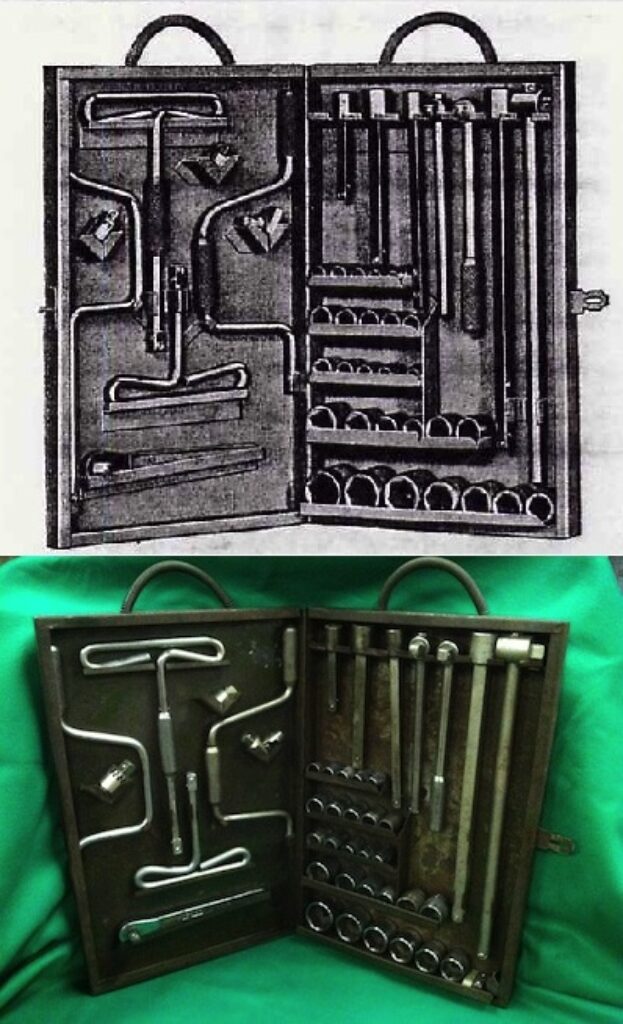
Brass Tags 1926-1932
Snap-on started as a 2-man company and did not have the ability to make everything they used. There is little doubt the boxes used to store and present the tools were purchased from outside.
One of the sources for Snap on boxes, cabinets and roll cabs is The “Metal Box & Cabinet Corporation” of Chicago, later known as “MBCentury, Metal Box Corporation” of Franklin Park, ILL and now is a part of “Edsal”. One of the likely sources is Cicero Chicago Corrugating Company, who was located at 1538-1546 51st Court, Cicero, Il, known for small metal boxes. A third source was purchased in 1958 and absorbed, there are probable several other box makers involved over the years. I guess there may have been one or more makers in Milwaukee in the 1927-1932-time period.
From 1923 – 1925 Snap-on used only decals. From 1932/3 Snap-on went back to decals and embossed metal panels in the cabinets and boxes. So the Brass Tag period is from 1926 to 1932. There are several know types of Brass tags.
In 1928 Snap on starting working toward the purchase and construction of a new manufacturing plant (Kenosha) and this plant opened in June 1930. There was a lot of inventory built to cover the move, and with the depression, this inventory lasted much longer than planned. Brass tags started to disappear after 1930 and seem to be totally gone by 1932. It appears stock existed after the move and the brass tag stock was use until depleted. All of the known brass tags read “Milwaukee” but the tool dates after June 1930 shipped from Kenosha in Brass Tagged sets. There is a location and date confusion.
I speculate these brass tags were riveted to boxes purchased from the outside. There appears to be some confusion on the types and dates of brass tags used.
Brass Tag Example A 1925/6
This is from a unique: an un-cataloged Super Service Set owned by Chad Shapiro. It is a hybrid between the 1925 (no brass tag) and the 1926 (brass tag) sets. It is likely a very late 1925 or very early 1926 tag. It reads “Snap-on Interchangeable Socket Wrenches Snap-on Wrench Co Milwaukee USA” no patent statement. It is the earliest Brass Tag I am aware of.

Brass Tag Example B 1926/7
This example comes from a 1926 Super Service Set and reads “Super Service Set Snap-on Interchangeable Socket Wrenches Snap-on Wrench Co Milwaukee, Wis.” – no patent statement. The patent claim may indicate a later tag, but this is speculation. This was also found on an early 1926 set.
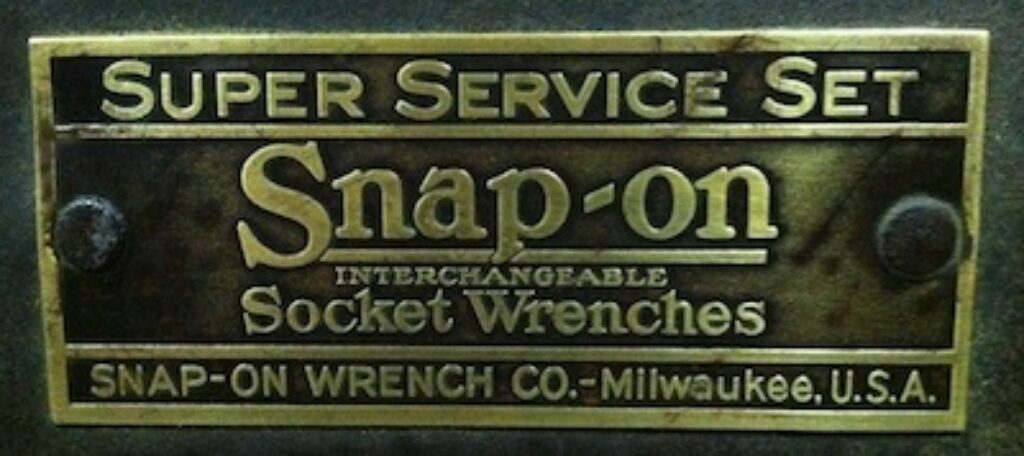
Brass Tag Example C 1927/9
This example is from the 1927-1929 period and is on a Super Service Set. It reads “Genuine Snap-on Socket Wrenches Manufactured By Snap-on Wrench Company Milwaukee Wis” “Reg US Pat off” It is early, and does not show the scroll at the bottom found in the later brass tags.
This is the first brass tag using red for the inlay. It continues into the tags below (the scoll tag).
This is from a Super Service Set owned by Mike Kalsem.

3rd Version of the Super Service Sets 1926 with Black Lacquer and Brass tags
In 1926 the target customer was evolving into auto mechanics and away from the industrial or building maintenance staff. The catalog description reflects this change. The box changes are easy to spot.
Paint finish – This version is painted in Black Lacquer
Tool Mounts and Locations. The location of the No 7 flat ratchet moved from the bottom to the top of the left side. The No 7 ratchet received a model change and has a hanger hole. This is to hang the ratchet, but there is an odd detail in these cabinets. The hanger hole was not used!! The ratchet is hung through the plughole. The plug must be removed and placed on the shelf. There is a flat hanger tab to hold the ratchet that cradles it on the other side. This is parallel to the top of the box.
The pockets are gone and hangers/Clips replaced them. The universal joint and the no 6-ratchet adapter mount to these hangers. The Tee and the speeders are also held in with hangers. There are 3 type of mounts 1) a narrow tab used for hanging and alignment, 2) wide “hanger” that can come straight out or have a 90 degree bend and 3) Clips, these are two hangers, but they have a spring action and the tools clip inside. Another feature are a series of 5 hangers in the upper left. These are commonly used for Flexockets or occasionally extra ½ sockets.
Labeling and Brass Tags There is a generic Snap on decal on the left side. It reads “Genuine Snap-on Interchangeable Socket Wrenches Snap-on Wrench Co Manufactured Milwaukee” in red and gold. There was a 2nd decal 3 X 6 ¼ that I would like to see. This example is missing this decal.
Hinge, Handle and Hasp layout. This set has the full-length piano hinge, top to bottom. The closure also changed to the more common hinged hasp. The male part of the hasp is spot welded from the inside and fits through a slot in the cabinet
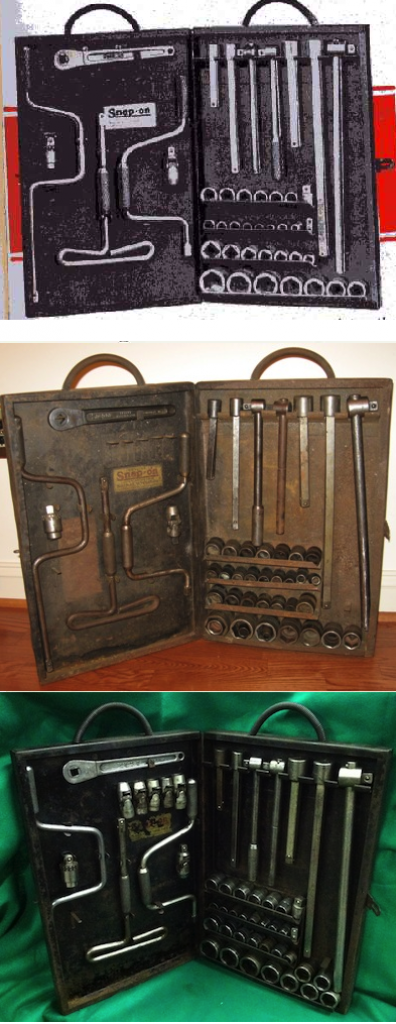
4th Super Service Set in 1927-1932 with Black Lacquer and Brass tag
In 1927 the Superset concept of putting an entire set in a single purpose built box is strained. There are tabs in the box that are for expanding the set after purchase. The box changes are:
Paint finish – This version is painted in Black Lacquer
Tool Mounts and Locations The tabs for the ratchet changed. A narrow tab now uses the hanger hole in the ratchet, anchoring the ratchet handle on the right side. The ratchet plug stays with the ratchet and the left side is supported with a 90-degree hanger tab. The 2 speeders and Tee remain, extra hangers exist for the No-6 ratchet adaptor (not shown in the catalog).
The Model 5 brace is replaced by the K-4-C speeder. The No 4 Speeder had no sleeve grip. This was the standard until 1927 and is seen in all pre 1927 Super Service Sets. In 1927 the No 4 Speeder is replaced with the K-4 Speeder with sleeved grip as shown here in this Super Service Set.
The clips changed to accommodate these wider sleeves. On the right side there is a single pocket for the 1/2 to 5/8 adaptor. The right side has the same 7 hanging handle and extension slots.
The two middle 2 socket shelves are longer. The top shelf is noticeably shorter and it no longer anchors to the middle shelves.
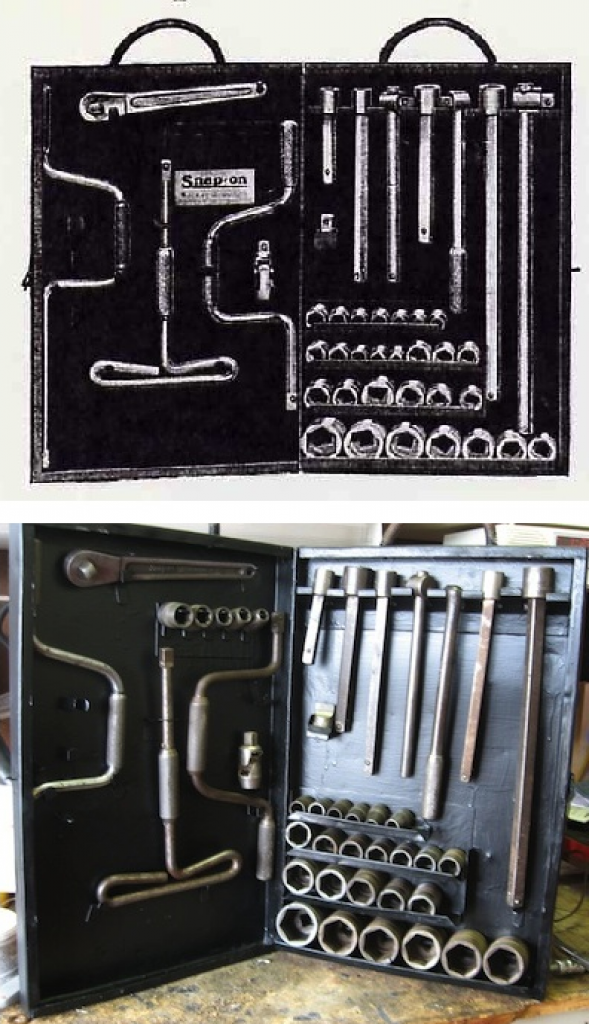
The last Super Service Set ? 1931/2
Here is another great example from Ken and Roseanna Johnson
This set belongs to Ken and Roseanna Johnson and is a unique and important addition. It is very late in the Brass Tag period, the latest known.
Paint finish – Black Lacquer
Tool Mounts and Locations – This matches and if the 4th Superset configuration
Labeling and Brass Tags – This set is unique. It has the Milwaukee brass tag. It is a scroll tag and is late in the brass tag period – Maybe the latest. It also has an embossed or stamped name in the cabinet. This is the next step in the progression. The Brass Tags stopped when the Embossed or stamped metal boxes and cabinets started. This is a great transition piece.
Hinge, Handle and Hasp layout – Matches
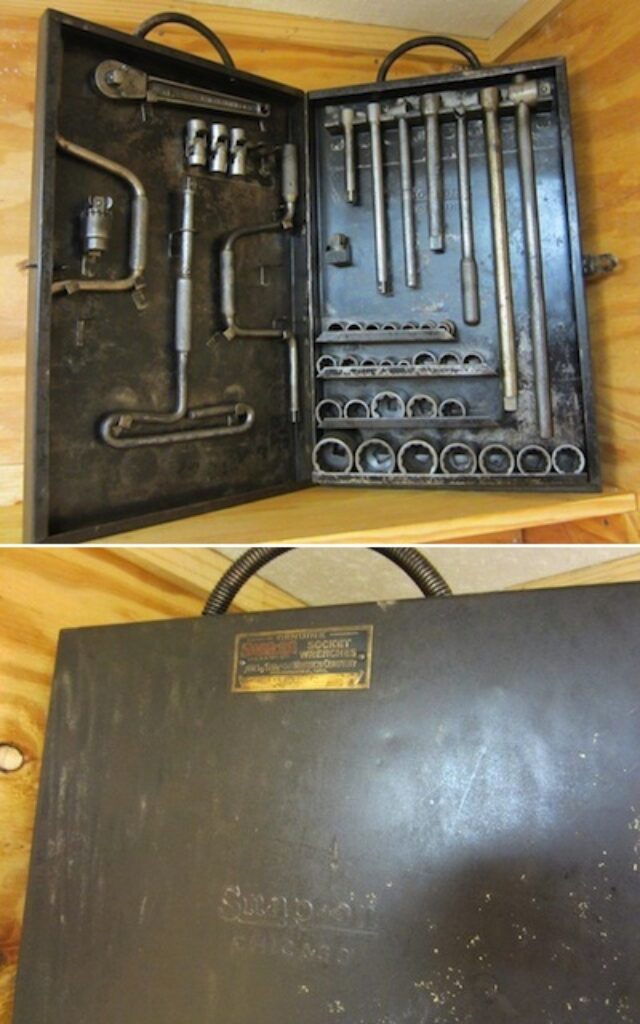
Super Service Sets 1948-1950
Lorem ipsum dolor sit amet, consectetur adipiscing elit. Ut elit tellus, luctus nec ullamcorper mattis, pulvinar dapibus leo.
In 1948 the 5073-GS-B Mechanic’s Basic Tool Set was introduced. It lasted through one catalog issues and was replaced with the 5074 – The cabinet carrier a KR-201 number
In 1950 the 5074-GS-B Mechanic’s Basic Tool Set replaced the 5073, but the cabinet is still the KR-201.
These are not popular and rather rare – If you should see one, please contact me
Collectors focus of the Brass Tag versions and the 1923 – 1925 sets. These were in the golden period for these sets. The large industrial sets from Kenosha never found the favor the smaller sets from Milwaukee had. The time for these sets moved on. They were replaced with larger tool storage options, roll cabs and tool chests. Still, they are interesting historical sets.
